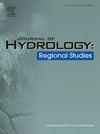Land cover change mitigated 20 % of the total increased evapotranspiration in tropical Lancang-Mekong River Basin during 2001–2019
IF 4.7
2区 地球科学
Q1 WATER RESOURCES
引用次数: 0
Abstract
Study region
The tropical Lancang-Mekong River Basin (TLMRB), Southeast Asia.
Study focus
Accurately assessing evapotranspiration (ET) change derived from land cover changes (LCCs) is challenging in tropical regions due to the large bias in existing ET products and the difficulty in improving the ET al.gorithm for tropical ecosystems. This study quantified the LCCs-driven ET in the TLMRB from 2001 to 2019 by using scenario simulations based on an improved MOD16 algorithm. A soil moisture index was introduced to improve the soil evaporation of the original MOD16 model.
New hydrological insights for the region
The improved MOD16 algorithm showed better performance with the average Root Mean Square Error decreasing by 0.12 mm/day compared with the original MOD16 ET. The improved ET of the wet climate conditions was more significant than that under dry climate conditions. LCCs led to a 3.45 mm/yr decrease in average ET, and mitigated 20 % of increased ET. LCCs caused a net reduction of 7.44 billion m³ in ET water consumption. This decrease in ET, may intensify the surface runoff and raise the risk of extreme floods in the rain season. These findings enhance our understanding of the relationship between LCCs and ET in tropical regions, and provide valuable insights for trans-boundary collaborations and water resource management in the TLMRB.
求助全文
约1分钟内获得全文
求助全文
来源期刊

Journal of Hydrology-Regional Studies
Earth and Planetary Sciences-Earth and Planetary Sciences (miscellaneous)
CiteScore
6.70
自引率
8.50%
发文量
284
审稿时长
60 days
期刊介绍:
Journal of Hydrology: Regional Studies publishes original research papers enhancing the science of hydrology and aiming at region-specific problems, past and future conditions, analysis, review and solutions. The journal particularly welcomes research papers that deliver new insights into region-specific hydrological processes and responses to changing conditions, as well as contributions that incorporate interdisciplinarity and translational science.
 求助内容:
求助内容: 应助结果提醒方式:
应助结果提醒方式:


